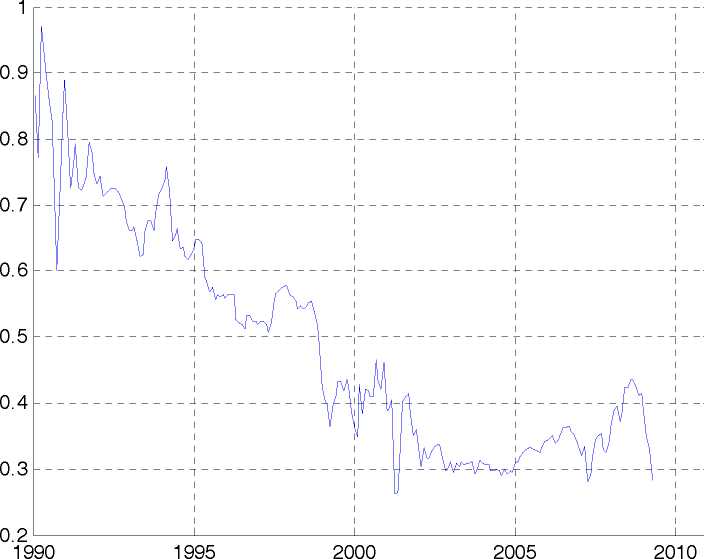In all cases we conclude that there is time variation, either in the form of non-
stationarity or in the form of structural breaks, which justifies the use of time-varying
parameters in the AR equation. Similarly, we test for the significance of the ARCH
and GARCH parameters of the model, finding that they are both significant. We
report in Table 1 the Ljung-Box test statistic for serial correlation of the residuals at
lags 1 to 4, showing that there is no residual autocorrelation at 5% level.
Charts 4-9 are based on the estimation results. Chart 4 shows trend inflation, namely
the estimated time-varying constant from Equation (4), which declines steadily from
the beginning of the 1990s up to the start of EMU, stabilising afterwards. The
estimates of the individual coefficients on lagged unemployment (not reported) are
not particularly informative, but it is clear that their sum, shown in Chart 5, is
negative throughout the sample. This is consistent with our earlier interpretation of
the data based on the Phillips curve model. It suggests again that this curve has
become flatter since the introduction of the euro, possibly reflecting a more firm
anchoring of inflation expectations.
Chart 4. EMU Trend inflation (month on month)

Chart 6 plots inflation persistence, defined as the sum of its autoregressive
coefficients. This exhibits a positive trend becoming negative at the beginning of the
third Phase of EMU, which may reflect lower and better-anchored inflation
expectations in the post-1999 period, consistently with the ECB’s mandate of
achieving long-term price stability and with theory. For instance, Erceg and Levin
(2003) show that inflation displays very little persistence if the long-run inflation
target is constant. Similarly, Orphanides and Williams (2005) demonstrate that if
long-run inflation expectations are well anchored, then inflation will be less persistent
than if the public is uncertain about the long-run inflation target.
More intriguing information
1. Fighting windmills? EU industrial interests and global climate negotiations2. Activation of s28-dependent transcription in Escherichia coli by the cyclic AMP receptor protein requires an unusual promoter organization
3. New Evidence on the Puzzles. Results from Agnostic Identification on Monetary Policy and Exchange Rates.
4. Cultural Diversity and Human Rights: a propos of a minority educational reform
5. The Prohibition of the Proposed Springer-ProSiebenSat.1-Merger: How much Economics in German Merger Control?
6. The name is absent
7. The name is absent
8. Are Japanese bureaucrats politically stronger than farmers?: The political economy of Japan's rice set-aside program
9. Assessing Economic Complexity with Input-Output Based Measures
10. Towards a framework for critical citizenship education